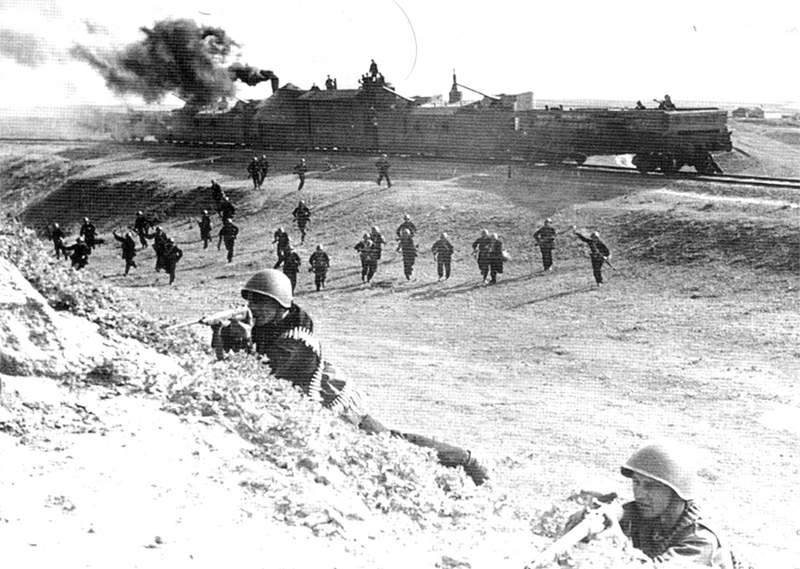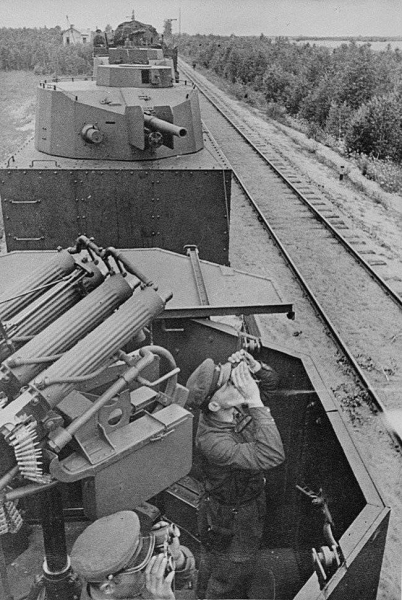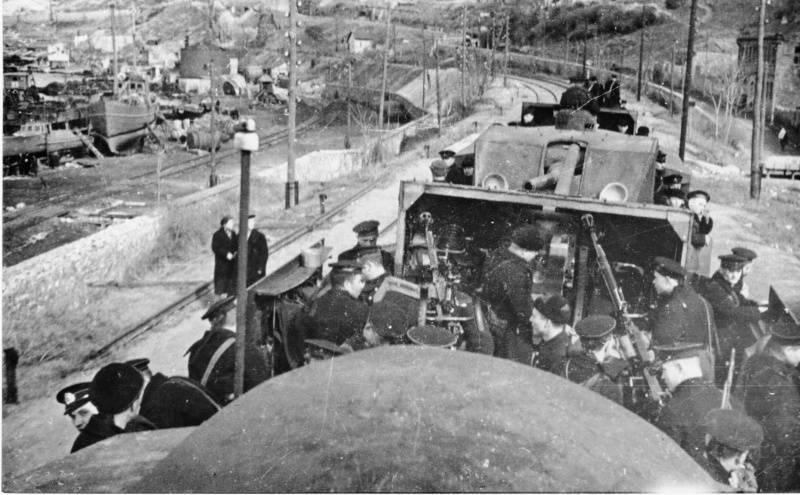
A huge reservoir of information on the work of armored combat, that exists today, surprisingly, rather it confuses the issue, than answers. The reason for this situation is that, that the majority of information sources were themselves participants in the events. Soldiers and commanders of armored trains Ever.
Without belittling the value of such information, Still we have to admit, that the participant in the events, whether soldier or officer, He has an idea only of "his" battle area, about their problems, about their feelings.


In order to collect more or less objective picture, be interviewed as much as possible of participants and, possibly, at both sides. What is impossible today. Archival documents also, especially the outbreak of war, many points were not mentioned. The confusion was complete.
Yes and material, that we offer, underscore, It is not a scientific work. We do not make conclusions. We do not analyze events, We do not put forward a new theory. We were just talking about, it is sufficient for many years was "not especially interested" our historians. More on the same side of the war.
Very often in various sources say, that the attitude towards the armored train was ambiguous in the prewar period. Recognizing firepower BP, mobility and maneuverability, serious enough armor protection, as well as the possibility of use as tractive force in case of need, Red Army leadership is still considered a future war engines of war. War aircraft and tanks.
This view is largely, in our opinion, correct. But quite controversial. Recall materials on the establishment of the pre-war period is sufficiently advanced PD.

Rather negative role was played by two factors. At first, inexcusably large reduction in the number of BP after the Civil War. In October 1920 , the Red Army had 103 armored train. At the beginning of the Great Patriotic all 53(!). Of which 34 It relates to the light class.
Secondly, transfer at the end of 1923 , the armored train under the jurisdiction of the Main Artillery Directorate not only contributed to their improvement, but also to transform the very essence of power supply to the role of mobile artillery batteries. GAU leadership openly considered it as an armored artillery on railway platforms.

by the way, is the answer for those of our readers, which discussed about the heavy rail guns and their corresponding complete PSU.
From previous submissions readers know the principles of the most famous armored train, their composition and purpose. I.e, in spite of difficulties, in the Red Army's armored train to the beginning of the war, not only preserved, but also gave rise to a lot of "descendants". Yes, and have themselves become quite different. no topics, that smashed the enemy in the Civil ...
As of 22 June 1941 the Red Army had 53 armored train (of them 34 relates to the light class), a part of which was 53 broneparovoza, 106 artillery broneploschadok, 28 broneploschadok defense and more 160 armored vehicles, adapted for movement by rail. there was also a 9 bronedrezin and several motor bronevagonov.
Besides the Red Army armored trains disposal and operating troops of the NKVD. They had 25 broneparovozov, 32 artillery broneploschadki, 36 motor and bronevagonov 7 armored vehicles.
Very often the question is about the NKVD armored trains. And the question has arisen from quite superficial view of our education, cinema and television at the very NKVD. The majority of the population had the firm conviction, that the NKVD was engaged only in search for enemies of the people, spies, saboteurs and their Disposal.
Brother, well yes, of course, even detachments, as without them ...
In fact, one of the main tasks of internal affairs was to protect the national economy facilities from sabotage. But the picture on the screen is not so colorful, as the arrest of a pest or spy. Or a machine gun in its retreating fighters.
railway junctions, station, space filling locomotives with water and coal, bridges, Stretches, warehouses were quite a desirable target for sabotage. Imagine even now exploded Transsiberian. And this in an age of motor trucks, aircraft and other vehicles. But before the war ...
In this way, we came to the answer to the question on the use of armored trains. Protection of the railway network facilities. In peacetime, from sabotage. In wartime, and from the advancing enemy, and from the aircraft, and from all, that may appear on the railroad. Including enemy armored and other armored vehicles. In particular - the enemy tanks.

Besides, during the evacuation of the situation we encountered often enough, when junctions for various reasons were cars with the most important goods. The money from the banks, archival and museum treasures to spare parts for airplanes and tanks and even evacuated plants machines.
To engage in the export of these compounds also had BP. In one part of the story we mentioned actions of the Soviet armored train, that alone for some time, not only repulsed station, where there was a structure with the necessary edge parts, but also ensured their export to the Soviet territory.
Even more prosaic tasks look for the Red Army armored trains. Speaking in a general sense, it is not even a problem, and task. And it is the task sounded simple: support infantry and other parts, operating in the band railroad.


But this task is concretized for each PSU, if it were separate armored train, or 2-3 armored train, if they were included in the division. So Leningrad Crimean armored perform multiple tasks.
They were mobile artillery batteries to deal with enemy artillery. Besides, defended the coast from enemy landings. They were mobile air defense batteries, who defended Leningrad sky, or the position of the Marine Corps in Crimea. Protect their own bases in the stations or nodes, which has not been removed ...


armored train, acting on the front, We had a few other problems. In the first months of the war, when surrounded fell divisions and corps, it is thrown at armored breakthrough Ring.
Huge loss of power supply especially in 1942 year due to a large extent it is this. Furthermore, namely armored troops were retreating rearguard.
There were cases, when BP went to fight with the German tank column. clear, that the chances of return of such trains was not. The tanks were originally much more maneuverable, and bumper 15-20 mm tank gun is not a hindrance.
They played a huge role in the defense of armored railway junctions and stations. Here they turned into quite serious air defenses. BP was a desirable goal for the German pilots, and estimates of air defense armored really wanted to "fill up the German". And piled. One of our armored trains had to his credit 15 downed aircraft.

But also the use of armored trains like no one has repealed mobile batteries. Trains were quite effective in counter-battery fight. And, by counter-battery fight in this case it is necessary to understand not only fights with enemy field battery, but also to fight against the enemy armored trains.
Known fight the Soviet "Ilya Muromets" and the German "Adolf Hitler", where our train was destroyed German, a perfect example of such a confrontation. Both armored trains in this battle, it is used as an artillery battery.
And the fight itself was made possible because of the sudden appearance of a serious artillery battery on the German side. After the destruction of the first German artillery took up pilots. but, the battery was not detected. And only then, when intelligence found German armored train, in the case has entered the "Ilya Muromets".
Armored trains have been another, quite heroic task. Guard trains. It could be trains with values, staff trains, even the hospital trains. Usually used for this purpose, or light armored air defense. The train was accompanied by a part in the danger zone. If necessary,, battle took.

On the way back to the armored train also carried out a combat mission for the protection and defense of the railway. Not just back, and controlled all approaches to the ways, all transfers and other objects.
Quite often, the PSU used for the transport of troops. So, we already know from the photo and the previous publications "Tula worker" ("Tula residents") It was built to carry out tasks for the destruction of enemy landings. Built in a conventional railway depot. From scrap materials, naturally.

Troopers often transported on control platforms and armored bay. It is from a photo of soldiers on an armored train, that with resolute faces looking ahead. This is not a staged photo.
Marines looked forward, not for the beautiful pictures in the photo. from Togo, how quickly they see the enemy and how quickly leave the platform, often depended on their lives. Armored landing platform - it is wonderful. almost impossible. But the transfer of the personnel of the other way around, business as usual. Wooden platform boards are not very reliable protection, even armored sandbags. Not all of the weapons can protect.

Furthermore, frequently commander BP received infantry units in the conduct independent combat operations. Troopers had been temporarily assigned to the crew of an armored train. And the train was turned into quite a fortified stronghold of the defense and a good help in the artillery attack.

Armored trains have been truly heroic task. Tasks, in which it is difficult to believe today. Armored train involved in the attack in the first echelon of our army! underscore, not in the second tier, where they supported the offensive, and in the first. on the fore, as they said the soldiers.
Imagine that today is difficult. true, even harder to imagine the strength of the spirit of the crew of the PSU. The word "heroism", we think, It does not fully reflect the greatness of the soldiers and officers. The greatness of railroad from the broneparovoza. The greatness of the paratroopers on the platforms ...

The famous Leningrad "Baltiets", built at the expense of workers in Leningrad-electrodepot 1941 year, not only successfully fought in the siege, but in January 1943 at the beginning of the year supported the advancing infantry fire, and then, during the decisive Soviet offensive, liberating the northern capital, "Baltiets" even moved ahead of the advancing! Armored train, followed by moving the advancing troops ...
The result of "personal war" of Soviet armored trains was the destruction of nearly four hundred of enemy tanks, about 350 guns, 840 guns, over 700 cars, 160 motorcycles, 115 downed aircraft, 2 enemy armored train.
But we paid dearly for the victory. AT 1941-43 years we have lost 65 armored train.
Today underestimate the contribution of armored trains and their crews are very simple and easy. The question is, that the victory was forged all, by infantryman to the front commander and the Supreme. So first and foremost its end, we set ourselves the task as much as possible to find and talk about the lesser-known pages of our history. combat mission.
The following material, continuing the theme, It will be the "Ilya Muromets" and "Adolf Hitler".











